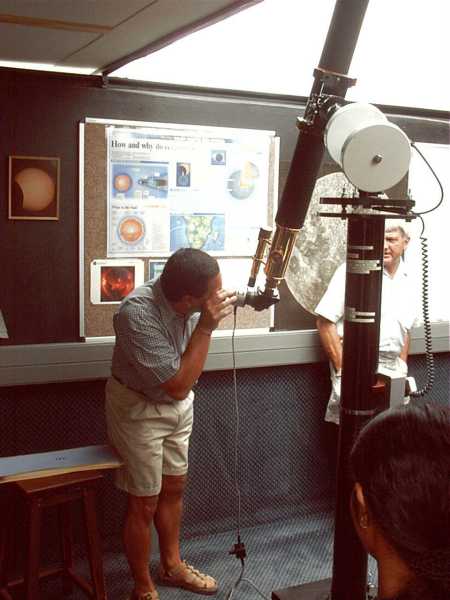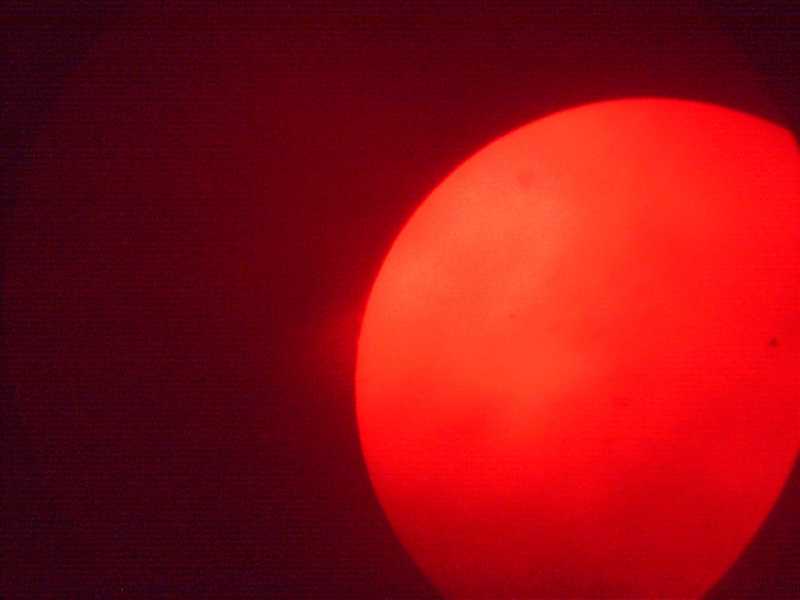|
On Saturday the 26 January, members and friends of the Centre visited the Solar Observatory atop the Wits University Physics building, an event kindly hosted by Tony Voorvelt. We met in the Planetarium car park (this being the part of Wits most generally known) then proceeded as a group. A few stragglers were directed by cell phone, with yet another group of late arrivals joining us a little later. The Sun had co-operated to the extent of rising as usual, but the advance order of clear skies was somehow lost in the bureaucracy… it was partly cloudy.
Undaunted, Tony proceeded to give us a run-down on the instrumentation and what we could expect to see when the clouds parted. This they did, intermittently, and several of us could see a small group of flares quite clearly - ethereal wispy tendrils hugging the edge of the sun. Less clear, but certainly obvious, were several sunspot groups, one quite large. A couple of us with cameras entered into mighty battle against resistentialism*, finally prevailing in our attempts to get a shot or two through the eyepiece. Tony was justifiably bemused by the camera flashes triggering automatically, but what can you expect from a "point & shoot". He was evidently giving us the benefit of the doubt, trying hard not to believe we thought it would help us get better pictures! While I doubt the fine detail will survive the printing process, herewith the fruits of our labors. The flares progressed visibly in "real time", which was quite exciting.
|
While people waited a chance to view through the intermittent breaks in the cloud, Tony continued to regale us all with a bombardment of related information. Jerry, another member of staff, who had briefly joined our telescope making class, brought up his German equatorial mounting for us to see. It sports a rather serious-looking worm & worm gear, all of it being machined from scratch. We look forward to seeing (and looking through) the entire instrument, which should be assembled in short order. Jerry popped into the TM class later that afternoon, to tell us that the sky had (naturally) cleared shortly after we dispersed, the Sun then putting on a spectacular display of activity in the form of an umbrella-shaped flare almost half a Solar diameter across. Considering that the events we had seen earlier had produced features large enough to swallow the Earth whole and not even burp, this must have been a truly awe-inspiring sight. Ah, c’est la vie, and all that.
|
The solar telescope, a refractor bequeathed to the Physics Department, was set on a temporary mounting pending the construction of a rather sturdier mount. While OK for visual use, the temporary mount is too shaky for serious photographic use. Apart from susceptibility to vibration, the assembly is too affected by gusts of wind hitting the telescope tube that juts above the walls of the observatory. Once on its permanent mount, the instrument will be able to accept a video camera, allowing real-time images to be piped to wherever they might be required, as well as allowing for video taping and of course frame grabbing for computer manipulation.
|
This observatory is an undergraduate facility designed to inspire interest in the physical processes abounding in the universe in which we live. Despite being put together on a shoestring budget, from what we saw this must surely be an endeavor that is highly likely to succeed. After all, the sun is visibly dynamic – it’s the only star we can see in detail, and there is certainly plenty of detail to be seen. That the detail changes visibly as we watch is rather exciting. Notwithstanding the Sun’s reliable habit of rising and setting so predictably, one glimpse through such a telescope will forever dispel any notion that this is a static, boring subject.
Tony, thanks. We look forward to a later visit once the Observatory is fully operational.
Chris Stewart*
resistentialism = "the apparently malicious behavior on the part of inanimate objects"Here are some more photos taken on the day............
 |
 |
|
 |